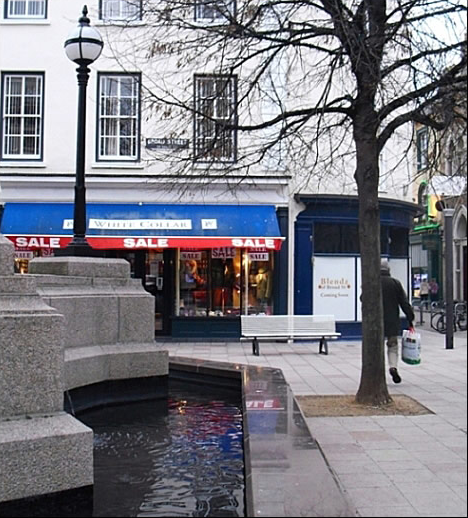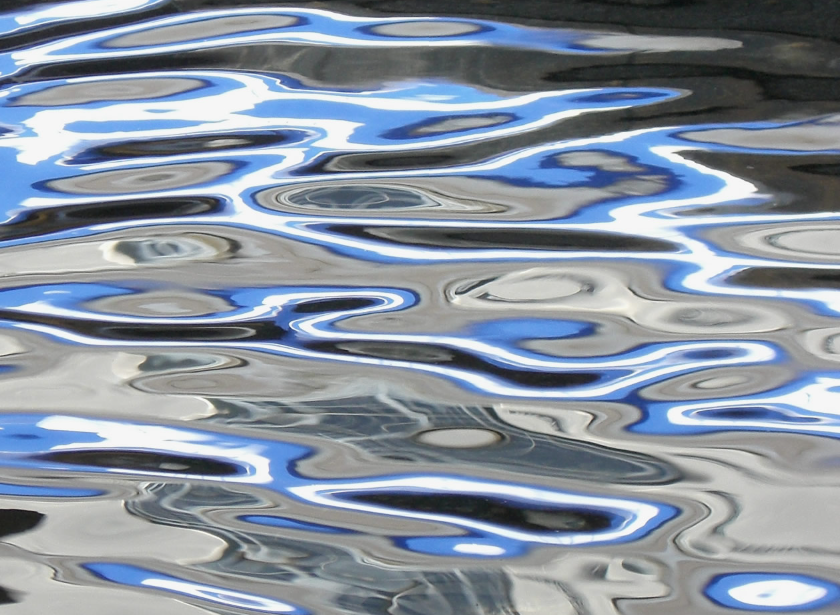OPOD - Sky Pools
OPOD - Sky Pools: A Fascinating Display of Reflections on Wavy Water
Sky pools, also known as skypools, are captivating phenomena that showcase ever-moving rings and swirls of light on the surface of wavy water. These mesmerizing reflections are not simple and straightforward but rather a complex interplay of the sky and its surroundings. One remarkable example of skypools was captured by Frank Le Blancq in Broad Street, St. Helier, Jersey. In this image, we can observe the reflections of the blue, white, and red shop awning, as well as fragments of words forming an intriguing "alphabet soup." The complexity and beauty of skypools lie in the intricate water surface contours and the unique way they distort and reflect the surrounding environment.
Unraveling the Complexity of Skypools
Unlike ordinary mirrors with fixed curvatures that produce simple and single images, skypools emerge from the undulating surface of wavy water. At any given moment, the curvature of the water changes from point to point along its surface, creating a dynamic and ever-changing reflection. These water surface contours give rise to a multitude of reflections that can be challenging to decipher.
To better understand the intricacy of skypools, let's delve into the ray diagram depicted in the image. The diagram showcases a particular viewing position and two-dimensional sinusoidal waves. The blue-colored rays represent the downward path of light from the surroundings, including the "Broad Street" sign, while the yellow rays illustrate their reflections back upwards into the observer's eye.
The Journey of Light Across the Water Surface
As we shift our gaze from position "a" on a wave towards the outer regions of the water surface, we witness a fascinating transformation in the reflections. Moving from "a" to "b," the reflected rays gradually approach the horizon, resulting in an inverted image. From "b" to "c," the reflections come from higher points in the sky, creating an upright image. The journey continues from "c" to "d" and beyond, where the reflection once again originates from lower points in the sky, inverting the image once more. This pattern repeats itself in subsequent wave troughs, giving rise to a mix of upright and upside-down sky views.
However, at position "e," a further complication arises. Some rays undergo a double reflection by the water surface before reaching the observer's eye, adding even more complexity to the skypool. Although these twice-reflected rays are not depicted in the diagram for clarity, they contribute to the formation of additional images within the skypool.
The Elegance of Water Surface Patterns
Real water surfaces exhibit undulations of varying wavelengths and directions, resulting in concentric oval bands of reflections within skypools. Frank Le Blancq's remarkable images beautifully illustrate these subtle water surface patterns. In one instance, the reflection of "BROAD STREET" appears inverted in the upper part of the skypool loop, while fragments of other words, such as "EET" and "STREET," present themselves in different orientations within the skypool.
Skypools are composed of several individual reflected images, each with its own unique characteristics. Some reflections may be inverted, while others remain upright. This intricate interplay of reflections creates a mesmerizing visual spectacle that showcases the enchanting nature of atmospheric optics.
In conclusion, skypools offer a captivating display of ever-moving rings and swirls of light on wavy water surfaces. The complexity of skypools arises from the dynamic water surface contours that distort and reflect the surrounding environment in unique ways. Through the interplay of reflections and undulating water surfaces, skypools create a visual symphony that challenges our perception and invites us to appreciate the beauty of atmospheric optics. Frank Le Blancq's remarkable images serve as a testament to the elegance and subtlety of water surface patterns within skypools. So, the next time you encounter these mesmerizing reflections, take a moment to marvel at the intricate dance between light and water that brings skypools to life.

Sky Pools & Alphabet Soup ~ Skypools are the ever moving rings and swirls of light on wavy water. They are the not so simple reflections of the sky and surroundings. These ones in a water trough surrounding a statue were imaged by Frank Le Blancq in Broad Street, St. Helier, Jersey. ©Frank Le Blancq, shown with permission.
The scene is at left. We see fragments of the blue, white and red shop awning in the reflections. Some reflections are wrapped tight into closed loops. At lower left in the main image is something more telling, fragments of words. They are the reflections of the "BROAD STREET" sign just visible on the wall of the white building between the two windows. Its reflections form an 'alphabet soup'. Some are the right way up, others inverted, others twisted. The sky reflections in ordinary skypools are hard to unscramble. The Broad Street alphabet soup shows that the reflections are not simple and straightforward.

The complexity of skypools comes from the involved water surface contours. Ordinary mirrors are flat, convex or concave. They produce simple and single images. They have a fixed curvature.
Wavy water is not so simple. Even at a single 'frozen' instant it changes its curvature from point to point along its surface. Its troughs are certainly concave at their deepest but the curvature decreases towards the crests passing through an inflection point and then becoming convex. And that is only in one dimension, the curvature alters differently in others.
At right is an accurately computed ray diagram for a particular viewing position and two-dimensional sinusoidal waves. The blue coloured rays come downwards from the surroundings including the "Broad Street" sign. The yellow rays are their reflections back upwards into the eye.
Let�s follow what happens as you look towards position �a� on a wave and then slowly look further outwards across the water surface. Moving from a to b we see reflections from points in the sky getting closer to the horizon. This is an inverted image.
From b to c the reflected rays instead come progressively from higher and higher points in the sky. This is a region where the reflection is upright.
From c to d and onwards the reflection again comes from lower and lower points in the sky as we look further along the wave. An inverted image.
In the next wave trough the process repeats itself to give more upright and upside-down sky views.
At e a further complication starts! Some rays are reflected twice by the water surface before they reach the eye. This adds yet more images. For clarity the diagram avoids showing these twice reflected rays.
Real water has undulations of several wavelengths and differing in other directions resulting in 'concentric' oval bands of reflections.
Frank Le Blancq's images with identifiable reflections neatly demonstrate the subtlety of water surface patterns.

'BROAD STREET is inverted in the upper part of the skypool loop. A fragment EET is the right way up at lower right. Part of another STREET reflection is at lower left. Skypools are made up of several individual reflected images, some inverted, some not.


Note: this article has been automatically converted from the old site and may not appear as intended. You can find the original article here.
Reference Atmospheric Optics
If you use any of the definitions, information, or data presented on Atmospheric Optics, please copy the link or reference below to properly credit us as the reference source. Thank you!
-
<a href="https://atoptics.co.uk/blog/opod-sky-pools-2/">OPOD - Sky Pools</a>
-
"OPOD - Sky Pools". Atmospheric Optics. Accessed on December 22, 2024. https://atoptics.co.uk/blog/opod-sky-pools-2/.
-
"OPOD - Sky Pools". Atmospheric Optics, https://atoptics.co.uk/blog/opod-sky-pools-2/. Accessed 22 December, 2024
-
OPOD - Sky Pools. Atmospheric Optics. Retrieved from https://atoptics.co.uk/blog/opod-sky-pools-2/.